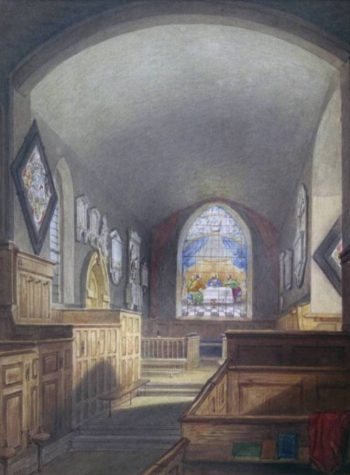The next Vicar was John Grainger who was to be in office for 38 years. He had a Cambridge degree and was evidently interested in the history of his parish contributing an informative paper on the subject to Records of Bucks (Vol V, pp.271 et seq.). He presumably implemented many of the changes encouraged by the Oxford Movement, designed to shake the Church of England out of what was perceived to be its 18th-century lethargy. They advocated brighter and livelier services, elaborate ritual, vestments, surplices, choirs, crosses and candlesticks, lecterns and even incense, few of which had been seen since the Reformation three centuries earlier. Elsewhere, these changes were often accompanied by bitter controversy and accusations of popery. In some parts of the country, preaching in a surplice or having a cross and candlesticks on the altar were enough to start a riot. Penn was never so extreme and the parish register records the wearing of a surplice as early as 1707 and the gift of a brass branch candlestick in 1749.
Hymns Ancient and Modern were first published in 1861, replacing metrical psalms announced by the parish clerk in many churches. It was often at this stage that organs were introduced to replace village musicians in the gallery and the earliest surviving churchwardens’ accounts for Penn, which run from 1857, show that an organ had already been installed by 1859, standing at the west end of the nave. It was worked by bellows and an annual payment was made for ‘organ blowing’.
We are on firmer ground in recording the structural changes introduced by the new Vicar, again inspired by the Oxford movement with the aim of restoring the appearance and arrangements of the church to their ideal of the medieval Decorated period (c.1280-1380). The new Vicar recorded in 1863 that ‘the interior was to a certain extent restored’, and listed the changes that had been made. Fortunately, our mainly 14th century nave and tower were seen as ‘correct’, but significant changes were made.
- The 18th century public gallery, which had been put up on the west wall of the nave by public subscription in 1733, was removed.
- The small choir gallery over the south door, put up in 1703, was removed. It had been paid for by the enthusiastic band of young men with their musical instruments, ‘that had learned to sing psalms’. We know that Sir George Grove’s father had had played the hautboy* in Penn church as a youth in the 1780s and 90s , but the gallery was no longer needed with an organ.
- The two-storey medieval south porch, with its side walls arched across the south aisle, which had provided the headroom for the choir gallery, was taken down. Judging by the ‘modern’ smoothness of the plaster, this removal resulted in a partial collapse of the central arch of the south aisle below the central clerestory window.
- The three–decker pulpit and any remaining covered private pews for the gentry families, some 7 ½ foot high, blocking both the central aisle of the nave and the chancel itself, which were noted in the 1637 Visitation, were removed.
- The east wall of the chancel, which had been completely rebuilt in brick with a new east window in the 1730s, was rebuilt with the knapped black flints fashionable at the time, and a more suitably Gothic east window was installed.
* A hautboy was an older form of oboe, often played with violin and bassoon
© Miles Green, Penn Parish Newsletter No.52, October 2017.
Photograph courtesy Eddie Morton ARPS

